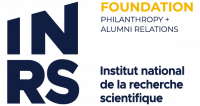Connor Rowe

“It is a great honour to receive this prize. The culmination of years of work which is my master’s thesis was a challenge to put together, but the final document along with this prestigious award signify to me how much I have developed as a scientist under the guidance of my mentors and the INRS community.”
Connor Rowe
Master in Energy and Materials science, 2024
Centre Énergie Matériaux télécommunications
Supervisor: José Azaña
Connor Rowe's master's thesis describes a new technique for real-time spectrogram analysis on arbitrary signals using photonics. The method increases performance by several orders of magnitude over the state of the art, while improving energy efficiency and cost.
The significant scientific value of his work is demonstrated by its publication as a featured article in the journal APL Photonics, with a patent pending in the USA. Connor has also presented his work at prestigious international conferences in eight countries, and received a letter from the President of Keysight Technologies Canada in support of a market assessment grant from the Natural Sciences and Engineering Research Council of Canada (NSERC).
What brought you to INRS and what do you remember about your experience?
It was the world class mentorship and collaboration opportunities that originally brought me to the INRS. It was also the groundbreaking research projects ongoing such as invisibility cloaks and quantum signal denoising. My research director, José Azaña, is someone who inspires incredible excitement for research and discovery throughout my studies and made it very easy to stay motivated. His group members, in particular Benjamin Crockett, also did an incredible job mentoring me through my first experiments and publications.
Can you describe the challenge and impact of the research presented in your master's thesis?
My master’s thesis describes a new technique for signal processing using fiber optics components which unlocks the analysis of an entirely new class of high-speed signals. It is both the fastest and broadest bandwidth method for real-time spectrum analysis to date. This sort of processing is essential for cognitive communications, sensing and ranging, optical telecommunications, radio astronomy, and ultrafast laser characterization.
What does winning this award mean to you?
It is a great honour to receive this prize. The culmination of years of work which is my master’s thesis was a challenge to put together, but the final document along with this prestigious award signify to me how much I have developed as a scientist under the guidance of my mentors and the INRS community.
What's the next chapter for you, now that you've graduated?
I will continue to doctoral studies with the same professor, José Azaña, at the INRS where I will endeavour to develop my own ideas which will hopefully be as impactful and exciting. I also have begun the first steps towards commercializing the technology which was the subject of my master’s thesis and will start a company during my studies if the investigations into market viability go well.
